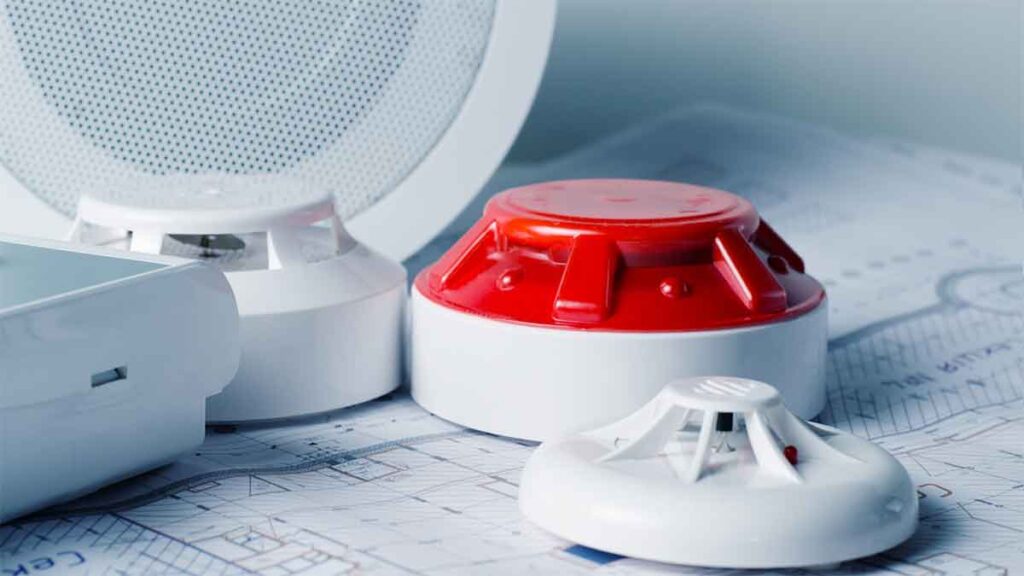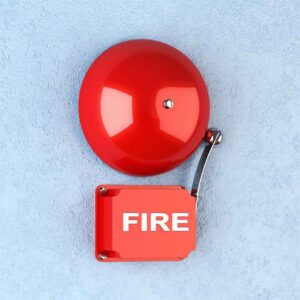Proper fire alarm design is vital for keeping commercial and residential buildings safe. An effectively designed fire alarm system can be the difference between a minor incident and a devastating disaster.
Beyond essential protection, investing in a customized system ensures quicker fire detection, rapid occupant evacuation, and strict adherence to fire safety regulations. An efficient, personalized fire alarm system minimizes damage and safeguards lives by reducing emergency response times and enhancing building safety.
Key Considerations for Fire Alarm System Design
Designing a reliable fire alarm system requires more than simply meeting code. It demands a careful balance between property-specific variables and regulatory standards. From structural layout and occupancy type to environmental exposure, each factor plays a critical role in determining the right components and configurations. A well-planned system ensures early detection, safe evacuation, and coordinated emergency response across all property types.
Modern fire alarm design services also account for integration with other fire protection systems, including fire sprinkler systems, emergency lighting, and voice evacuation technology. These combined efforts help minimize damage, reduce evacuation time, and meet both NFPA 72 and local jurisdiction requirements.
What Are the Design Considerations for Fire Safety?
Every building presents different fire safety challenges, and a fire alarm system must be designed to address them effectively. The layout of the property determines the placement of alarms, ensuring that no area is left unmonitored.
High-risk locations, such as kitchens, storage rooms, or mechanical areas, require specialized smoke, heat, or gas detection sensors. In multi-tenant properties or high-occupancy buildings, alarm zoning ensures alerts reach the correct areas without unnecessary disruptions.
Fire safety also depends on how well the fire alarm design integrates with other protection systems. Alarms should work in tandem with fire sprinkler systems, emergency exits, and lighting to guide people to safety during an emergency. Proper evacuation planning is just as critical as early detection—clear exit signage, emergency lighting, and audible alarms help prevent confusion and reduce evacuation times.
What Factors Influence Fire Alarm System Design?
Designing for fire safety begins with understanding the physical attributes and operational use of the property. Designers assess layout complexities, including compartmentalization, open areas, and vertical spans in high-rise buildings. These characteristics affect sensor placement and alert distribution. Clear coverage ensures that no area is overlooked during an emergency.
Occupancy classification is another major design driver. Hospitals, schools, warehouses, and data centers each present different fire risks and response requirements. A hospital, for example, demands silent alarm protocols and smoke detection sensitive enough to protect vulnerable patients. Warehouses, in contrast, require robust sensors adapted to wide-open spaces and high storage racks.
Additionally, aligning alarms with evacuation routes, access points, and emergency exits guarantees that alerts are actionable. Well-marked paths supported by synchronized alarms and emergency lighting help ensure swift, safe movement during evacuation.
Compliance and Fire Alarm Design Regulations
Every fire alarm system must follow applicable regulations to function correctly and legally. These rules exist to ensure alarm systems are suited to a building’s layout, occupancy type, and fire risk level. Non-compliance can result in failed inspections, insurance disputes, fines, or unsafe conditions during emergencies.
Jurisdictions often have specific codes outlining where detectors must be placed, how frequently systems must be tested, and what equipment must be included. For commercial and high-occupancy properties, the standards are especially strict. A properly designed fire alarm system will align with all local requirements and integrate smoothly with other emergency systems, such as sprinklers and evacuation protocols.
What Is the Design Code for Fire Alarms?
Fire alarm systems must follow the National Fire Protection Association (NFPA) 72 code, which establishes industry-wide guidelines for system installation, inspection, testing, and maintenance. This standard ensures that alarms provide early detection, accurate alerts, and seamless integration with fire protection services like sprinklers and emergency exits.
In addition to NFPA 72, the Occupational Safety and Health Administration (OSHA) requires businesses to maintain functional fire alarm systems as part of workplace safety compliance. OSHA regulations mandate regular inspections, proper employee training, and clearly defined emergency procedures.
Local fire codes, such as those enforced by Los Angeles County, introduce additional regulations that refine fire alarm placement, zoning, and integration with emergency response systems. Depending on their size, layout, and risk factors, buildings may be required to use specific alarm types—such as addressable, conventional, or hybrid systems—A fire alarm design company ensures that all system components align with these standards, reducing the risk of compliance violations.
Are There Regulations for Fire Alarm Systems?
Fire alarm systems are governed by detailed regulations that vary by property type:
- Commercial buildings must have zoned alarms, audible and visual notification, and routine performance checks.
- Industrial properties often need reinforced components and specialized sensors to handle extreme conditions.
- Residential structures, especially apartment complexes, require interconnected alarms and centralized monitoring to protect multiple occupants effectively.
Regulations also define how often systems must be inspected and maintained. Working with an experienced fire alarm design company ensures your system stays compliant, functions reliably, and passes all required inspections without delays or costly corrections.
How Custom Fire Alarm Design Improves Safety
A custom fire alarm system design enhances fire safety by addressing a building’s specific needs rather than relying on a standard, one-size-fits-all approach. Every property has unique fire risks, structural characteristics, and occupancy considerations that influence how an alarm system should function. Customization ensures optimal sensor placement, faster fire detection, and seamless integration with other fire protection services, such as sprinklers and emergency lighting.
A well-designed alarm system does more than sound an alert—it minimizes response time, improves evacuation efficiency, and reduces the risk of property damage. High-occupancy buildings, industrial facilities, and healthcare institutions require different alarm configurations to ensure safety for all occupants. By working with an experienced fire alarm design company, businesses and property owners can implement tailored solutions that enhance security, improve regulatory compliance, and maximize emergency preparedness.
How Does Custom Fire Alarm Design Work?
Custom fire alarm design starts with a detailed property assessment to identify specific risks, building characteristics, and occupancy needs. Fire protection specialists evaluate how the space is used, where hazards exist, and how the building layout might affect sensor placement and alarm performance. For instance, a hospital may require ultra-sensitive smoke detection in patient areas, while a warehouse might demand heat sensors to address higher fire loads and open layouts. Understanding these variables ensures the system is tailored for maximum coverage and responsiveness.
Once the assessment is complete, designers select the appropriate detection technologies and develop a system that integrates with other fire protection services such as fire sprinklers, emergency lighting, and monitoring platforms. Smoke, heat, and multi-sensor detectors are strategically placed to ensure accurate and timely alerts. The final design not only meets compliance requirements but also supports faster emergency response by creating a coordinated safety infrastructure that functions seamlessly across the entire building.
What Common Issues Are Found During Fire Inspections?
Routine fire inspections frequently reveal safety gaps that could compromise a building’s fire protection system. Some of the most common issues include:
- Malfunctioning alarms – Sensors may be faulty, batteries depleted, or wiring disconnected, making the system unreliable.
- Obstructed devices – Alarm components hidden behind furniture, decorations, or structural elements may fail to detect fire threats.
- Outdated equipment – Older alarm models may not comply with modern fire codes, requiring upgrades to maintain legal and functional standards.
- Blocked evacuation routes – Hallways, stairwells, or emergency exits cluttered with storage materials or furniture create hazards during an evacuation.
- Lack of regular maintenance – Dust accumulation, improper sensor calibration, and system neglect can lead to false alarms or delayed activation.
Addressing these concerns requires proactive engagement with a qualified fire protection company that provides regular inspections, maintenance, and upgrades. Keeping fire alarm systems in top condition ensures that they function correctly when needed most, protecting lives and assets while maintaining compliance with fire safety regulations.
Long-Term Benefits of a Well-Designed Fire Alarm System
Investing in expertly designed fire alarm systems delivers substantial long-term benefits. Proper design significantly reduces fire risk, protecting people and property, minimizing costly repairs, and avoiding extended business downtime. Regular testing and maintenance further enhance reliability, ensuring the system performs correctly in emergencies. Insurance providers recognize and reward businesses with professionally maintained systems, offering reduced premiums for compliance with fire safety standards.
How Can Fire Inspections Improve Tenant Safety?
Routine inspections greatly enhance tenant safety by verifying that fire alarm and fire sprinkler systems remain fully functional. Inspections ensure compliance with regulations and identify potential hazards before they become emergencies. Regular drills and evacuation training further prepare tenants for emergency scenarios, boosting overall preparedness. Property owners foster confidence among tenants and occupants by implementing proactive safety measures, reducing the risk of fire-related injuries or fatalities.
What Are the Key Benefits of Fire Inspection Services?
Regular fire inspections provide several essential advantages. Firstly, inspections detect hazards early, reducing the likelihood of severe incidents. Routine assessments help maintain continuous compliance with local and national fire codes, protecting businesses from legal repercussions and fines. Effective inspections and maintenance enhance property value by demonstrating responsible management and commitment to occupant safety. Additionally, proven compliance and proactive fire protection measures can significantly reduce insurance costs, saving money in the long term.
Secure Your Building with Expert Fire Alarm Design
Custom fire alarm design services provide tailored solutions that enhance early detection, minimize response time, and ensure seamless integration with other fire protection services. Investing in a professionally designed system reduces risks, strengthens compliance, and delivers peace of mind, knowing your property is fully protected against fire threats.
At Kimble & Company Fire Protection Systems, we specialize in fire alarm system design, expert fire alarm installation, and comprehensive compliance solutions. With over 40 years of experience, we have been a trusted fire protection company serving Los Angeles and Orange County, delivering customized, code-compliant fire safety solutions. Protect your property with expert fire protection—contact Kimble & Company Fire Protection Systems today to schedule a consultation and ensure your building is equipped with the highest level of fire safety.



